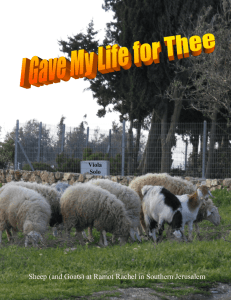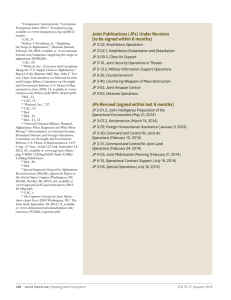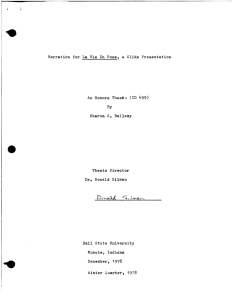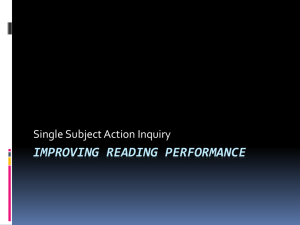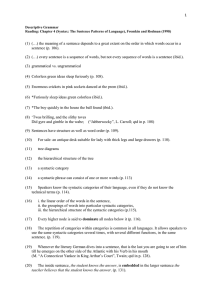Key Challenges for Ensuring Food Security in South Africa’s Inner Cities
advertisement
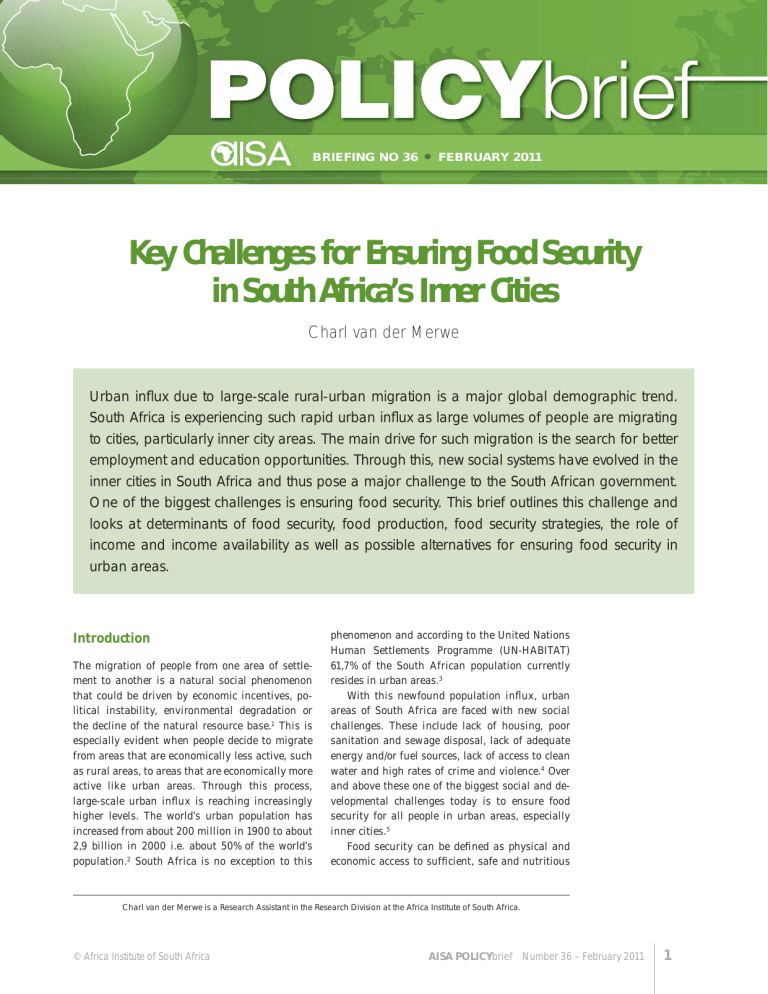
BRIEFING NO 36 ● FEBRUARY 2011 BRIEFING G NR 2 APRIL 2008 Key Challenges for Ensuring Food Security in South Africa’s Inner Cities Charl van der Merwe Urban influx due to large-scale rural-urban migration is a major global demographic trend. South Africa is experiencing such rapid urban influx as large volumes of people are migrating to cities, particularly inner city areas. The main drive for such migration is the search for better employment and education opportunities. Through this, new social systems have evolved in the inner cities in South Africa and thus pose a major challenge to the South African government. One of the biggest challenges is ensuring food security. This brief outlines this challenge and looks at determinants of food security, food production, food security strategies, the role of income and income availability as well as possible alternatives for ensuring food security in urban areas. Introduction The migration of people from one area of settlement to another is a natural social phenomenon that could be driven by economic incentives, political instability, environmental degradation or the decline of the natural resource base.1 This is especially evident when people decide to migrate from areas that are economically less active, such as rural areas, to areas that are economically more active like urban areas. Through this process, large-scale urban influx is reaching increasingly higher levels. The world’s urban population has increased from about 200 million in 1900 to about 2,9 billion in 2000 i.e. about 50% of the world’s population.2 South Africa is no exception to this phenomenon and according to the United Nations Human Settlements Programme (UN-HABITAT) 61,7% of the South African population currently resides in urban areas.3 With this newfound population influx, urban areas of South Africa are faced with new social challenges. These include lack of housing, poor sanitation and sewage disposal, lack of adequate energy and/or fuel sources, lack of access to clean water and high rates of crime and violence.4 Over and above these one of the biggest social and developmental challenges today is to ensure food security for all people in urban areas, especially inner cities.5 Food security can be defined as physical and economic access to sufficient, safe and nutritious Charl van der Merwe is a Research Assistant in the Research Division at the Africa Institute of South Africa. © Africa Institute of South Africa AISA POLICYbrief Number 36 – February 2011 1 foods which meet an individual’s dietary needs and preferences for an active and healthy life.6 Three key dimensions to urban household food security can be identified. These are food availability, food access and food utilisation.7 One of the main issues is that urban residents have to purchase most of the food they consume as opposed to rural areas where people can produce their own food. Urban food security is therefore highly dependent on money and thus it becomes imperative that sufficient attention is given to the challenges of generating efficient and stable income as prerequisite for ensuring food security in urban areas. This brief analyses the plight of food insecurity in urban areas with specific focus on the innercities of South Africa. Attention has been given to income generation and affordability of food in an urban context. The hypothesis is that due to food insecurity in urban areas a spiral of urban based poverty is emerging. Determinants of Food Security in Urban Areas Food availability in an urban area is largely determined by food supply to cities.8 Food supply systems include a complex distribution chain which involves wholesalers, intermediaries, distributors and street vendors.9 Such a distribution chain has the potential of increasing the price of food which has a negative consequence due to vulnerability of the urban poor to price increases. This vulnerability mainly stems from limited income or limited opportunities to generate income.10 Notably, access to food goes hand-in-hand with income availability.11 The urban poor often pay more for food since they are forced to buy small quantities of food due to limited income. As could be noted, food prices are a critical factor and determinant of urban food security. They are a single factor to which the urban poor are extremely vulnerable. According to Ruel and Garrett, food prices depend on five factors. Which are: ● the efficiency of the food marketing systems in urban areas; ● the buying patterns of the household. This refers to whether the family buys their food in bulk or in small quantities as well as where they purchase their food; ● the ability of the household to produce some of the food it needs through systems of urban agriculture; ● the household’s access to public transfers such as food aid programs or subsidies; and 2 AISA POLICYbrief Number 36 – February 2011 ● macroeconomic policies of governments, including food policies 12 Against the background of the global economic meltdown and the use of certain staple diet foods (e.g. maize) for fuel, food prices have increased exponentially. For example, in Southern Africa food prices are experiencing above-average highs, especially for staple crops like maize.13 In South Africa, in particular, the price of maize have risen by 20% in the past year, the price of dairy products by a third and the price of bread has increased by 20%.14 This means that poor households are now spending 37% more on these basic food items that in turn reduces people’s ability to access food. This is particularly true for market dependant vulnerable households. Another important dimension of urban food security is food utilisation.15 There are notable differences between eating patterns of different ethnic and cultural groups and between urban and rural areas in South Africa. For instance the white population of South Africa typically consumes a diet which has a high fat intake, low carbohydrate, low fibre and high free sugar.16 In a typical diet of white urban residents the meal pattern includes three meals per day of which one meal is the main meal.17 The main meal normally contains a staple food such rice and/or potatoes, a generous portion of meat or chicken and at least two types of vegetables.18 On the other hand, two distinct diets can be distinguished among the black African population. The rural black African population follows a traditional diet, which is high in carbohydrates, low in fat and sugar and moderately high in terms of fibre intake.19 The black urban residents have lower fat intake and higher carbohydrates. Other food items which are consumed in large quantities in urban areas include among others cereals (98,5% of people), stimulants like tea and coffee (72,6% of people) and products with high sugar content like cold drinks (89,1% of people).20 It can therefore be said that the urban black African population is showing signs of transforming to the Western-style diet.21 Accompanied with these changes in lifestyle and consumption habits is a decrease in physical activity, increased tobacco use and alcohol consumption.22 In contrast to this physical activity is high in rural areas as result of farming and other livelihood activities that form part of daily life. All the above-mentioned changes in urban lifestyles and diets have a negative effect on the health of urban residents and this poses a great health challenge for urban dwellers. The high intake of fats increases the proneness of these © Africa Institute of South Africa populations to diet-related non-communicable diseases (NCDs) like obesity, hypertension, diabetes and strokes.23 Obesity has further increased to such a degree that cardiovascular diseases such as coronary heart disease and strokes are showing an increase in developing countries. Obesity further brings about a situation where an individual is predisposed to such cardiovascular risk factors.24 In addition, the increased use of tobacco has led to the number of deaths from lung cancer in developing countries increasing by 30% in recent years.25 This nutrition transition in urban areas and the subsequent higher intake of fat, sugar and salt is at the core of health problems. Food Production and Food Security in Urban Areas of South Africa Food security primarily depends on the amount of food that is produced in a country. If sufficient amounts of food are not produced domestically countries need to import from other countries. This in turn increases the price of food which in turn leads to higher levels of food insecurity. South Africa produces its main staple foods and exports any surplus amounts of food which is mainly sourced from large-scale commercial farms.26 Field crops, livestock and horticulture are the main agricultural sectors of South Africa with wine and fruit production growing substantially in the past decade. South Africa has a dualistic agricultural economy, meaning a well-developed commercial farming sector co-exist with a small-scale farming sector, which is mainly practised on the basis of subsistence farming.27 Agricultural output is the main difference between these two sectors. Commercial farming is mostly controlled by white farmers who are able to generate sufficient financial resources to apply modern farming technologies and improved farm management techniques in order to raise productivity of farms. This means that agricultural production especially in this sector has nearly doubled during the past thirty years and is the main contributor to food security.28 Subsistence farming on the other hand, which is more common in rural areas, lacks technological and financial input and is therefore more vulnerable to disasters such as droughts and flooding. Although agriculture is practised in both rural areas and on commercial farms, the input to food security in terms of production volume is higher on commercial farms. Commercial farms are profit-driven, which means that food availability and affordability is largely © Africa Institute of South Africa driven by the economic principles of supply and demand. This can negatively affect food security especially in inner cities where residents do not always have a constant income flow. Apart from producing sufficient amounts of food through commercial farming, there is a need to develop policies that will accentuate the attainment of sufficient levels of food security for all citizens of a country. Since 1994, the South African government intended to increase public spending in order to improve the food security of many South Africans, particularly those who were in a historically disadvantaged position through various legislation and policies. There have been land reform policies and programmes that were aimed at transferring 33% of arable land to previously disadvantaged communities. These programs included the Land Reform Programme of 1994 which had three branches namely Land Restitution, Land Redistribution and Land Tenure Reform.29 An additional program aimed at redistributing land for farming purposes was the Land Redistribution for Agricultural Development Programme (LRAD) of 2000. LRAD was intended to assist people in acquiring lease land for agricultural purposes. The general feeling was further that LRAD should be strictly for purposes of commercial farming.30 The situation however remained unsatisfactory until 2000, when the government decided to formulate a national strategy to deal with food security issues in the country. This strategy is called the Integrated Food Security Strategy for South Africa (IFSS).31 The vision of the IFSS is in accordance with the definition of food security offered by the Food and Agricultural Organisation of the United Nations (FAO). The vision is ‘to attain universal physical, social and economic access to sufficient, safe and nutritious food by all South Africans at all times to meet their dietary and food preferences for an active and healthy life.’32 The IFSS uses a development approach that entrenches public private civil society partnerships and focuses on the food security of households while still keeping national food security in mind.33 The operation of the IFSS can be summarised as follows: ● Food security interventions will ensure that the target population that experiences food security gains access to productive resources; ● If a segment of this population is unable to gain access to such resources, food security interventions will ensure that those people gain access to income and job opportunities to enhance its purchasing power; ● Food security interventions will empower people to have access to safe and nutritious food; AISA POLICYbrief Number 36 – February 2011 3 Figure 1 Average Household Incomes in Cities of South Africa (in ZAR) 300 000 250 000 Number of households 200 000 150 000 100 000 50 000 Over 132 000 72 001-132 000 18 001-72 000 0-18 000 None 0 Annual Income (in ZAR) City of Cape Town City of Tshwane Port Elizabeth Johannesburg Durban Source: Charl van der Merwe and Dr T. Simelane of AISA ● ● Food security interventions will provide that the state provides relief measures in conditions of disability or extreme conditions of destitute; and Food security interventions will precede using analysis that is grounded on accurate information of which the impact will be constantly monitored and evaluated.34 In spite of this promising picture, South Africa faces a wide spectrum of challenges for ensuring food security. These challenges range from issues at national level to issues at household level. At the national level these challenges at the time of the adoption of the IFSS were inadequate safety nets for the country’s poor and weak disaster management systems.35 This refers to the fact that South Africa does not yet have a structured system of how to respond to food security disasters such as droughts or floods.36 At the national level, the challenge is to create economic conditions that would favour poor households that suffer from food insecurity. 4 AISA POLICYbrief Number 36 – February 2011 At the household level, many families have insufficient and unstable food supplies. Additionally, many households do not have the capabilities to produce enough food. Further challenges are the lack of access to funds in order to purchase food, which has as underlying problem limited income opportunities as well as poor nutritional status.37 These challenges still remain evident today and improvement has to be made on both national and household levels. Dealing with these issues has to be a continued process by policy makers in government and civil society. Income Generation and Availability as Determinant of Food Security Urban residents, especially in inner cities, need income to survive and to ensure food security for themselves and their families. Thus, they need stable employment in order to ensure a stable and constant level of income. In this regard, there exist © Africa Institute of South Africa Figure 2 Average Income Expenditures in Cities of South Africa (in ZAR) 2 500 Income Expenditure 2 000 1 500 1 000 500 Tshwane Johannesburg Port Elizabeth Durban Cape Town 0 City Food Transport Accommodation Electricity Source: Charl van der Merwe and Dr T. Simelane of AISA significant income differences between cities of South Africa (see Figure 1). This implies that the vulnerability of urban residents to food insecurity also differs among cities. According to De Swardt et al. (2005), five sources of income exist in South Africa. These are wages, grants, temporary employment, selfemployment and other sources of income. Wages constitute the largest source of income, almost 60%, while social grants are the second-highest source of income, especially in rural areas, at 17%.38 It is important to note that the expenditure of urban residents also differs significantly among the cities of South Africa (see Figure 2). Thus, higher expenditure on food paired with other commodities such as accommodation, transport and electricity means that urban residents have less money to spend on other necessities for ensuring a healthy and sustainable livelihood. Urban Agriculture as an Alternative for Ensuring Urban Food Security Urban agriculture is one of the main alternatives for ensuring urban food security and how to © Africa Institute of South Africa ensure that people in urban areas have sufficient food resources. The contribution of urban agriculture to food security is a subject that has been researched and documented in many countries in the developing world as an important facet of urban survival. The United Nations Development Programme (UNDP) in 1996 identified several potential advantages of urban agriculture: For the poorest of the poor, it provides good access to food. For the stable poor, it provides a source of income and good quality food at low cost. For middle-income families, it offers the possibility of savings and a return on their investment in urban property. For small and large entrepreneurs, it is a profitable business.39 In South Africa urban agriculture is also viewed as one policy option to strengthen the asset base of the urban poor. Rogerson (2000) argues that the debates surrounding urban agriculture in South Africa in essence have been divided into two different schools. The first school which is the mainstream group is generally positive and very optimistic about the contribution that urban agriculture can make. An evaluation was made on the use of urban agriculture in Cape Town and it was AISA POLICYbrief Number 36 – February 2011 5 concluded that it ‘offers gardeners an opportunity to become involved in a development strategy which holds tremendous potential and which can expand into an entrepreneurial activity.’40 Thus, it can be used for more than solely the production of food. Income generation in an urban context is as important as the means to produce food based on the premise that urban residents have to buy most of the food they consume. The second school or viewpoint regarding urban agriculture in South Africa is that of people who suggest that caution should be exercised not to view urban agriculture as anything more than an alternative safety net for the urban poor. Rogerson argues that urban cultivation plays a modest role and that the most optimistic claims are more congruent with the discourse on development than with the actual practice of cultivation.41 A perspective like this is not necessarily against urban agriculture as a tool to address the needs of the urban poor, but it makes the plea that urban agriculture needs to be understood in terms of those who undertake it. The discourse would then be ‘more in line with the practice, views and aspirations of the cultivators themselves.’42 There are however difficulties that the implementation of urban agriculture in South Africa still faces. In most provinces and municipalities there are no clear, coherent policies that can guide the management of the implementation of urban agriculture in South Africa.43 Access to land with secure tenure is another obstacle for municipalities and local governments. A lack of co-operation between municipal departments, NGOs and community-based organisations (CBOs) that are involved in urban agriculture is also a constraining factor in some cities. Apart from these institutional constraints, there are social and resource constraints too. The first big resource constraint, as already mentioned, is the access to sufficient land with secure tenure. Urban zoning is an important aspect to consider here since sufficient vacant land is needed in order to successfully promote urban agriculture. Access to sufficient water resources is the second big constraint regarding resources.44 Water is a key factor in agricultural productivity and Sub-Saharan Africa suffers from a serious lack of investment in the development of water resources.45 Among the various social constraints the most frequently encountered include a lack of commitment of participants once land has been secured, a culture of dependency, infighting between competing groups for control of resources; skill deficiencies on the part of participants and project co-ordinators and theft.46 6 AISA POLICYbrief Number 36 – February 2011 Conclusion and Recommendations The rising food insecurity in urban areas is a great cause for concern. This needs to be dealt with through concrete and clearly defined policies and/ or effective implementation strategies. There is a need to rethink current policies of urban development and current urban programming. Therefore, it is imperative that more attention is given to the following: ● Income generation in urban areas and specifically inner-cities. New forms of income generation should also be researched and developed in order to ensure stable levels of income for longer periods of time. ● Food production through urban agriculture and urban gardening. Co-operation is needed between all role-players in managing the implementation of urban agricultural projects, including municipalities, local governments and city councils. Attention should be given to the question of whether South African cities would be able to create sufficient space for urban agriculture. Zoning of specific land for the use of urban agriculture is here a factor to consider for policymakers and urban planners. ● The sources of food in terms of where food comes i.e. if the food is coming from commercial markets outside the city or from markets in the city itself. ● Concerted efforts are needed to ensure that urban and inner-city environments are healthier for the people who live there. This includes giving more attention to research on the nutritional status of urban populations. ● Improving strategies through which the urban poor gain access to food. This should particularly form part of municipal strategies. ● Efficient allocation of funds for food supplementation programs and nutrition education programs. To conclude, it is imperative to note that ongoing research on the issue of urban and especially inner city food security is needed in order to fully understand the complex dynamics of this issue and to acquire more information on the diverse conditions and the different stakeholders regarding food and nutrition insecurity in urban centres. This would include adopting a more integrated and holistic approach to these problems. More detailed and in-depth knowledge through research will be one of the key tools to combat the ongoing struggle for survival of so many urban residents in the modern African city of the 21st century. © Africa Institute of South Africa Notes and References 19 Ibid. 1 21 Ibid. 2 3 4 5 6 Balbo, M and Marconi, G. 2005. “Governing international migration in the city of the south”. Global Migration Perspectives Number 38. http://www.gcim.org/attachements/ GMP%20No%2038.pdf (accessed 10 October 2008). Millennium Ecosystem Assessment. 2005. Urban Sytems. Ecosystems and Human Well-Being: Current State and Trends. Findings of the Condition and Trends Working Group. Millennium Ecosytem Assessment Series Volume 1. Washington D.C.: Island Press. (http://www.millenniumassessment.org/ documents/document.296.aspx.pdf accessed 17 October 2008). The Centre for Development and Enterprise (CDE). 2005. Land Reform in South Africa: A 21st century perspective, Research Report No 14 (Abridged version). (http://www.cde. org.za/article.php?a_id=36 accessed 19 July 2010). Steyn, NP. 2006 . Nutrition and Chronic Diseases of Lifestyle in South Africa. Chronic Diseases of Lifestyle in South Africa: 1995-2005. Medical Research Council Technical Report. (http://www.mrc.ac.za/chronic/cdlchapter4.pdf accessed 21 January 2009). Human Sciences Research Council (HSRC). 2004. Food Security in South Africa: Key policy issues for the medium term. Position Paper. (http://www.hsrc.ac.za/research/ outputDocuments/2394_DeKlerk_FoodSecurityinSA.pdf accessed 4 December 2008). Kennedy, G. 2003. Food Security in the context of urban subSaharan Africa. Internet Paper for Food Security, FoodAfrica, Internet Forum 31 March – 11 April 2003. (http://foodafrica. nri.org/urbanisation/urbspapers/GinaKennedyFoodsecurity.pdf accessed 24 November 2008). 20 Ibid. 22 Ibid. 23 Bourne, L.T. and Steyn, K. 2000. Rural/urban nutrition-related differentials among adult population groups in South Africa, with special emphasis on the black population. South African Journal of Clinical Nutrition 13 (1). 24 International Council for Science (ICSU). 2007. Health and Human Well-being in Sub-Saharan Africa. Pretoria: ICSU Regional Office for Africa. 25 Ibid. 26 Republic of South Africa, Department of Agriculture. 2002. The Integrated Food Security Strategy for South Africa. (http:// www.info.gov.za/view/DownloadFileAction?id=70243 accessed 8 January 2009). 27 Encyclopedia of the Nations. 2008. South Africa Agriculture. (http://www.nationsencyclopedia.com/economies/Africa/SouthAfrica-AGRICULTURE.html accessed 21 January 2009). 28 Ibid. 29 Kirsten, J.F. and Van Zyl, J. 1999. Approaches and Progress with Land Reform in South Africa. Agrekon 38. 30 Wegerif, M. 2004. A Critical Appraisal of South Africa’s market-based land reform policy: The case of the Land Redistribution for Agricultural Development (LRAD) programme in Limpopo. Research Report (19). Programme for Land and Agrarian Studies, University of the Western Cape. 31 The Integrated Food Security Strategy for South Africa, 2002. 32 Ibid. 7 Ibid. 33 Ibid. 8 Ibid. 34 Ibid. 9 Ibid. 35 Ibid. 10 Ibid. 36 Ibid. 11 Ibid. 37 Ibid. 12 Ruel, M.T. and Garret, J.L. 2004. “Features of Urban Food and Nutrition Security and Considerations for Successful Urban Programming. Journal of Agricultural and Development Economics 1 (2), pp 242–271. (ftp://ftp.fao.org/docrep/ fao/007/ae227e/ae227e00.pdf accessed 17 November 2008). 38 De Swardt et al., 2005. 13 Family Early Warning Systems Network (FEWS NET). 2008. Southern Africa Food Security Update September 2008 (http://www.fews.net/docs/Publications/south_2008_09.pdf accessed 17 November 2008). 14 Wahenga Regional Hunger and Vulnerability Programme. 2008. What will higher global food prices mean for poor consumers and small farmers in southern Africa? Wahenga Policy Brief (15) (www.wahenga.net/uploads/documents/briefs/ Brief_15_higher_food_prices_s.pdf accessed 12 January 2009). 15 Kennedy, 2003. 39 Hampwaye, G., Nel, E. and Rogerson, C.M. 2007. Urban agriculture as local initiative in Lusaka, Zambia. Environment and Planning C: Government and Policy 25, pp 553–572. (http://www.envplan.com/epc/fulltext/c25/c7p.pdf accessed 17 November 2008). 40 Rogerson, C. 2000. Coping with Vulnerability in Africa: Urban Agriculture and Poverty Alleviation. Africa Insight 30 (3/4), pp 66–72. 41 Ibid. 42 Ibid. 43 HSRC Position Paper, 2004. 44 HSRC Position Paper, 2004. 17 Ibid. 45 Rosegrant, M.W. et al. Facing Alternative Futures: Prospects for and Paths to Food Security in Africa. International Food Policy Research Institute (IFPRI) 2020 Africa Conference Brief 17. (http://www.ifpri.org/pubs/ib/ib39.pdf accessed 17 November 2008). 18 Ibid. 46 HSRC Position Paper, 2004. 16 Steyn, N.P. et al., 2006. Dietary Changes and the Health Transition in South Africa: Implications for Health Policy. Cape Town: South African Medical Research Council. © Africa Institute of South Africa AISA POLICYbrief Number 36 – February 2011 7 BRIEFING BRIE BR IEFI IE FING FI NG G NR NR 2 Towards Africa-oriented Risk Analysis Models A contextual and methodological approach Africa Fast Facts A Africa In Focus A C Compiled by GIS and Cartography (AISA) C C Compiled by GIS and Cartography (AISA) C I ISBN 978-0-620-426-25-1 PPrice R 100,00 I ISBN 978-0-620-426-24-4 PPrice R 100,00 Towards Africaoriented Risk Analysis Models Electoral Process and the Prospects for Democracy Consolidation Electoral Process and the Prospects for Democracy Consolidation A Contextual and Methodological Approach Edited by Korwa G. Adar, Abdalla Hamdok and Joram Rukambe Edited by Korwa G. Adar, Richard O. Iroanya, and Francis Nwonwu Edited by Korwa G. Adar, Richard O. Iroanya, and Francis Nwonwu ISBN 978-0-7983-0213-5 Price R 120,00 Edited by Korwa G Adar, Abdallah Hamdok and Joram Rukambe ISBN 978-0-7983-0210-4 Price R 120,00 The Millennium Development Goals Africa Insight ISSN 977-025-628-000-6 Price R 35,00 The Millennium Development Goals Achievements and prospects of meeting the targets in Africa Achievements and Prospects of Meeting the Targets in Africa 1. Eradicate Eradicat adicate d extreme extreme poverty an and h hung unger ge 2. Achieve evee universal universal prim primary edu education ucation n 3 Promote 3. Prom omote gende enderr equality and and empower em mpower women 4. Reduce child mortality Edited by Francis Nwonwu 5. Improve p e maternal health 6. Combat HIV/AI V/ DS DS, ma malaria and other dise diseases 7. Ensure environmental environmental sustainability sustainab 8. Develop elop a glo global bal partn partnership for development ISBN 978-0-7983-0121-8 Price R 120,00 Edited by Francis Nwonwu Africa A-Z Continental and Country Profiles A-Z: Continental and country profiles, Second edition Greening the Great Red Island Madagascar in Nature and Culture Edited by Pieter Esterhysen Edited by Jeffrey C. Kaufman ISBN 798-0-7983-0199-2 Price R 250,00 ISBN 978-0-7983-0181-7 Price R 120,00 S Scholarly Publishing in Africa African Political Elites A T Search for Democracy The and Good Governance a Scholarly Publishing in Africa EEdited by Francis Nwonwu a and Dirk Kotze PO Box 630, Pretoria, 0001, South Africa No 1 Embassy House, Bailey Lane, Arcadia, Pretoria Tel: +27 (0)12 304 9700 Fax: +27 (0)12 323 8153 pubs@ai.org.za www.ai.org.za opportunities & impediments I ISBN 978-0-7983-0184-8 PPrice R 120,00 APRIL APRI AP PR RIL RI L 2008 200 20 08 opportunities & impediments edited by Solani Ngobeni O Opportunities & Impediments Im EEdited by Solani Ngobeni IS 978-0-7983-0227-2 ISBN PPrice R 250,00 PO Box 630 Pretoria 0001 South Africa No 1 Embassy House Bailey Lane Arcadia Pretoria Tel: +27 (0)12 304 9700 Fax: +27 (0)12 323 8153 E-mail: ai@ai.org.za ai@ai.org.za,, Website: www.ai.org.za AISA is a statutory research body focusing on contemporary African affairs in its research, publications, library and documentation. AISA is dedicated to knowledge production, education, training and the promotion of awareness on Africa, for Africans and the international community. This is achieved through independent policy analysis, and the collection, processing and interpretation, and dissemination of information.

